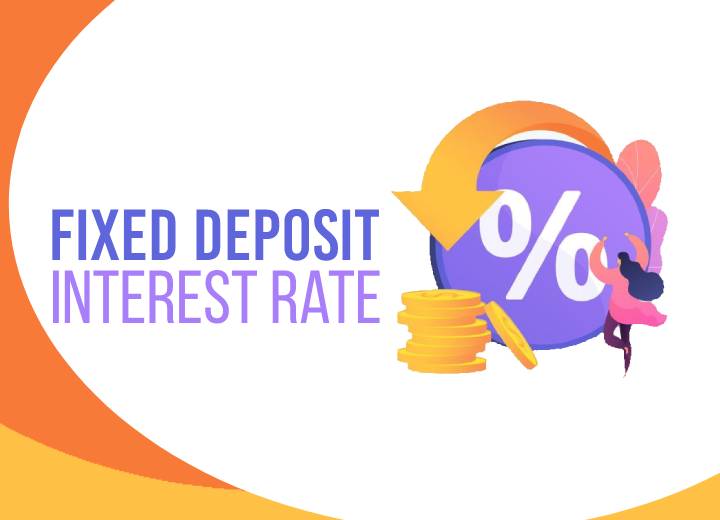Fixed Deposits (FDs) are a popular investment instrument in India, primarily due to their assured returns and relative safety compared to more volatile investment options like stocks. However, ensuring that one gets the best possible returns from their FD requires a thorough understanding of FD interest rates and affecting factors. This article delves into the crucial tips that can guide investors in choosing the right FD interest rates.
Understanding FD Interest Rates
The FD interest rate is the rate at which your deposit grows over the specified tenure. It dictates the amount of interest earned by the end of the deposit term. These rates can vary significantly based on several factors:
1. Deposit Tenure:
– Typically, longer tenures attract higher interest rates.
– For instance, if ₹1,00,000 is invested for a tenure of 1 year at an interest rate of 6%, the maturity amount at the end of the tenure would be ₹1,06,000. However, the same amount invested for 5 years at 7% will yield more due to the higher interest rate and compounding effect.
2. Type of Depositor:
– Senior citizens often get a higher interest rate.
– Banks usually offer around 0.25-0.50% more for senior citizens.
3. Type of FD:
– Cumulative FDs, where interest is compounded and paid at maturity, generally offer slightly higher rates compared to non-cumulative FDs, where interest is paid at regular intervals.
Using a Fixed Deposit Calculator
A Fixed Deposit Calculator is a handy tool that can assist in understanding how much interest one will earn over a specific period. Here is a simple breakdown:
– Principal Amount (P): The initial amount invested.
– Rate of Interest (r): The annual interest rate.
– Tenure (t): The investment period (in years).
Using the formula for calculating the maturity amount:
\[ M = P \times \left(1 +\frac{r}{100}\right)^t \]
For instance:
– If you invest ₹1,00,000 at an interest rate of 7% for 5 years, the calculation would be as follows:
\[ M=1,00,000\times \left(1+ \frac{7}{100}\right)^5 = 1,00,000 \times (1.07)^5 = 1,00,000 \times 1.403 = ₹1,40,300\]
By leveraging a Fixed Deposit Calculator, such calculations can be simplified, saving time and ensuring accuracy.
Evaluating Bank Offerings
FD interest rates are not uniform across all banks. Different banks offer varying rates based on their liquidity and internal policies. Comparing FD interest rates across multiple banks is essential.
1. Public Sector Banks:
– Generally offer slightly lower interest rates compared to private banks. However, they come with a higher sense of security and trust.
2. Private Sector Banks:
– May offer higher interest rates to attract more deposits.
– Using a Fixed Deposit Calculator can assist in comparing which bank provides better yields based on tenure and deposit amount.
3. Non-Banking Financial Companies (NBFCs):
– Often offer higher interest rates but come with a higher risk as compared to traditional banks.
Additional Considerations
1. Interest Payout Frequency:
– FDs can be structured to pay interest on a monthly, quarterly, half-yearly, or annual basis, or at the end of maturity.
– Cumulative fixed deposits often offer higher effective yields due to compounding.
2. Premature Withdrawal:
– Some banks charge a penalty for premature withdrawal of FDs.
– It’s pivotal to understand these terms as they can significantly affect the returns.
3. Tax Implications:
– Interest earned on FDs is taxable as per the investor’s income tax slab.
– TDS (Tax Deducted at Source) is applicable if the interest exceeds ₹40,000 in a financial year (₹50,000 for senior citizens).
4. Reinvestment:
– Upon maturity, reinvesting the maturity amount can enhance returns, especially if reinvested in cumulative FDs, benefiting from the power of compounding.
Conclusion
Choosing the right FD interest rate is a pivotal decision that requires careful evaluation of multiple parameters. A thorough comparison of banks through tools like the Fixed Deposit Calculator can significantly aid this process, ensuring investors maximize their returns. The interplay of deposit tenure, interest payout frequency, type of depositor, and tax implications must be gauged comprehensively to make an informed decision.
Summary
Selecting the appropriate FD interest rates requires a multi-faceted approach. Key factors influencing these rates include deposit tenure, type of FD, and the financial institution. Longer tenures usually suggest higher rates, and senior citizens often benefit from elevated interest rates. Utilizing a Fixed Deposit Calculator simplifies understanding different bank offerings and their comparative returns. Evaluating public and private sector banks, along with NBFCs, ensures well-informed decisions. Special attention to interest payout frequency, premature withdrawal terms, and tax implications further refines the investment strategy. A comprehensive assessment of these elements can optimize FD returns while balancing safety and profitability.
Disclaimer:
Investors should carefully evaluate all pros and cons and stay informed about the complexities inherent in the Indian financial market before making investment decisions.




tdp8b 12 Jun 2025
oral zithromax 250mg – tinidazole 300mg canada metronidazole 200mg ca
Glenna 12 Jun 2025
70918248
References:
anabolic steroids dianabol (Glenna)
kudbiser.com 12 Jun 2025
70918248
References:
injectable anabolic Steroid (kudbiser.com)
Stephan 12 Jun 2025
70918248
References:
is testosterone steroids (Stephan)
npo eurasia 13 Jun 2025
Please let me know if you’re looking for a article writer for your blog. You have some really good posts and I think I would be a good asset. If you ever want to take some of the load off, I’d absolutely love to write some material for your blog in exchange for a link back to mine. Please blast me an email if interested. Regards!
top up uc pubg 13 Jun 2025
It’s in point of fact a great and useful piece of info. I am glad that you simply shared this helpful information with us. Please keep us informed like this. Thank you for sharing.
http://www.simplytiffanychalk.com/2014/03/24/tcelebrations-a-flower-by-any-name/ 13 Jun 2025
70918248
References:
Anabolics.com [http://www.simplytiffanychalk.com/2014/03/24/tcelebrations-a-flower-by-any-name/]
Wanda 13 Jun 2025
70918248
References:
steroid body transformation (Wanda)
permata 4d 13 Jun 2025
I am curious to find out what blog system you’re utilizing? I’m having some minor security problems with my latest blog and I’d like to find something more risk-free. Do you have any recommendations?
old.newcroplive.Com 13 Jun 2025
70918248
References:
legal steroids bodybuilding supplements – old.newcroplive.Com,
Mueenahmed.Com 14 Jun 2025
70918248
References:
Anabolic Steroids Are Most Chemically Similar To (Mueenahmed.Com)
cwkie 14 Jun 2025
order rybelsus 14mg pills – cyproheptadine generic periactin cost
Fuel Pump 14 Jun 2025
I am not sure where you are getting your info, however good topic. I needs to spend a while finding out more or figuring out more. Thank you for magnificent info I used to be looking for this information for my mission.
none 14 Jun 2025
70918248
References:
none
sidegra 14 Jun 2025
obviously like your web-site but you need to check the spelling on quite a few of your posts. Several of them are rife with spelling problems and I find it very bothersome to tell the truth nevertheless I will surely come back again.
joinkite.org 14 Jun 2025
70918248
References:
none – joinkite.org,
Verena 14 Jun 2025
70918248
References:
none (Verena)
sincan 88 14 Jun 2025
I conceive you have observed some very interesting points, thankyou for the post.
https://rivercityramble.stlouligans.com/river-city-ramble-podcast-episode-145-the-big-collab-part-1-ft-city-sc-report-stl-soccer-news 14 Jun 2025
70918248
References:
none (https://rivercityramble.stlouligans.com/river-city-ramble-podcast-episode-145-the-big-collab-part-1-ft-city-sc-report-stl-soccer-news)
Kareem 14 Jun 2025
70918248
References:
none (Kareem)
Https://newsstroy.kharkiv.ua 15 Jun 2025
70918248
References:
none (https://newsstroy.kharkiv.ua)
Www.Toycarland.Com 15 Jun 2025
70918248
References:
None (http://Www.Toycarland.Com)
none 15 Jun 2025
70918248
References:
none
nagaempire 15 Jun 2025
Regards for helping out, superb information.
tiny house 15 Jun 2025
I am extremely impressed along with your writing talents and also with the layout to your blog. Is this a paid subject matter or did you customize it yourself? Anyway stay up the excellent high quality writing, it’s rare to see a nice blog like this one nowadays..
rateio concurso policia federal perito 15 Jun 2025
I’ve recently started a blog, the info you offer on this website has helped me greatly. Thanks for all of your time & work. “Men must be taught as if you taught them not, And things unknown proposed as things forgot.” by Alexander Pope.
Read More Here 15 Jun 2025
This design is spectacular! You most certainly know how to keep a reader entertained.
Between your wit and your videos, I was almost moved to
start my own blog (well, almost…HaHa!) Excellent job.
I really enjoyed what you had to say, and more than that, how you presented it.
Too cool!
ducati canarias 15 Jun 2025
An impressive share, I just given this onto a colleague who was doing a little analysis on this. And he in fact bought me breakfast because I found it for him.. smile. So let me reword that: Thnx for the treat! But yeah Thnkx for spending the time to discuss this, I feel strongly about it and love reading more on this topic. If possible, as you become expertise, would you mind updating your blog with more details? It is highly helpful for me. Big thumb up for this blog post!
rateio curso policia federal pf 16 Jun 2025
Excellent goods from you, man. I have have in mind your stuff previous to and you are just extremely fantastic. I actually like what you’ve got right here, certainly like what you’re stating and the way in which wherein you are saying it. You make it enjoyable and you still take care of to keep it smart. I can’t wait to read much more from you. This is really a terrific website.
ufxee 16 Jun 2025
buy motilium sale – order cyclobenzaprine 15mg sale purchase cyclobenzaprine for sale
ayuda PFG arquitectura 16 Jun 2025
Some truly excellent blog posts on this web site, appreciate it for contribution. “There is one universal gesture that has one universal message–a smile” by Valerie Sokolosky.
mat de yoga 16 Jun 2025
It’s actually a great and helpful piece of info. I’m satisfied that you shared this helpful information with us. Please keep us up to date like this. Thanks for sharing.
rateio concurso policia federal perito 16 Jun 2025
With havin so much written content do you ever run into any problems of plagorism or copyright violation? My site has a lot of completely unique content I’ve either created myself or outsourced but it seems a lot of it is popping it up all over the web without my agreement. Do you know any techniques to help prevent content from being ripped off? I’d definitely appreciate it.